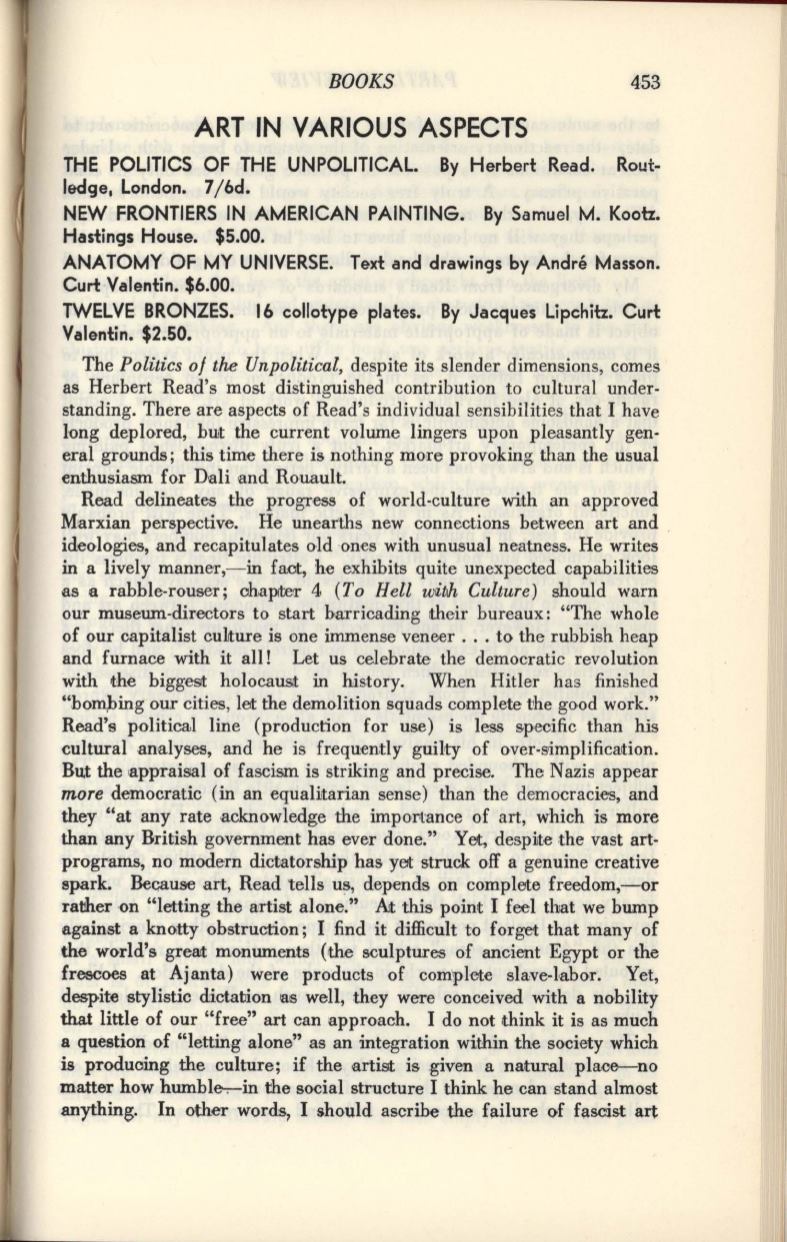
BOOKS
453
ART IN VARIOUS ASPECTS
THE POLITICS OF THE UNPOLITICAL. By Herbert Read. Rout–
ledge, London. 7/6d.
NEW FRONTIERS IN AMERICAN PAINTING. By Samuel M. Koob:.
Hastings House. $5.00.
ANATOMY OF MY UNIVERSE. Text and drawings by Andre Masson.
Curt Valentin. $6.00.
TWELVE BRONZES. 16 collotype plates. By Jacques Lipchib:. Curt
Valentin. $2.50.
The
Politics of the Unpolitical,
despite its slender dimensions, comes
as Herbert Read's most distinguished contribution to cultural under·
standing. There are aspects of Read's individual sensibilities that I have
long deplored, hut the current volume lingers upon pleasantly gen–
eral grounds; this time there is nothing more provoking than the usual
enthusiasm for Dali and Rouault.
Read delineates the progress of world-culture with an approved
Marxian perspective. He unearths new connections between art and .
ideologies, and recapitulates old ·ones with unusual neatness. He writes
in a lively manner,-in faot, he exhibits quite unexpected capabilities
as a rabble-rouser; chapter 4
(To Hell
wiM-1,
Culture)
should warn
our museum-directo·rs to start barricading their bureaux: "The whole
of our capitalist culture is one immense veneer ... to the rubbish heap
and furnace with it all! Let us celebrate the democratic revolution
with
the
biggest holocaust in history. When Hitler has finished
"homping our cities, let the demolition squads complete the good work."
Read's political line (production for use) is less specific than his
cultural analyses, and he is frequently guilty of over-simplification.
But the 'appraisal of fascism is striking and precise. The Nazis appear
more
democratic (in an equalitarian sense) than the democracies, and
they "at any rate acknowledge the importance of art, which is more
than any British government has ever done." Yet, despite the vast art–
programs, no modern dictatorship has yet struck off a genuine creative
spark. Because art, Read tells us, depends on complete freedom,-or
rather on "letting the artist alone." At
this
point I feel that we bump
against a knatty obstruction; I find it difficult to forget that many of
the world's great monuments (the sculptures of ancient Egypt or the
frescoes at Ajanta) were products of complete slave-l,abor. Yet,
despite stylistic dictation as well, they were conceived with a nobility
that
little of our "free"
art
can approach. I do not think it is as much
a question of "letting alone" as an integration within the society which
is
producing the culture; if the artist is .given a natural place--no
matter how humble--in the social structure I think he can stand almost
anything. In other words, I should ascribe the failure of fascist art


